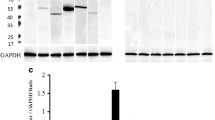Summary
In an attempt to localize components of the renin angiotensinsystem in the pineal gland of rats, immunocytochemical studies using the PAP-technique were performed with antisera against angiotensin I, angiotensin II and angiotensinogen. The staining pattern thus obtained was not only the same for the three antisera, but was also identical to that shown for many other peptide-antisera in the literature. In those studies, the immunocytochemical staining had been ascribed to a distinct pineal cell population or to cell processes. However, by examining adjacent semithin and ultrathin sections by immunocytochemistry and electron microscopy, respectively, we could identify the extracellular perivascular compartment and its flocculent material as the site of staining.
This unexpected localization and the observation of “immunoreactivity” of some preimmunsera in the same compartment as well as several additional findings and arguments are taken to suggest the likelihood of “pseudopositive” immunostaining, typical for the pineal gland.
Similar content being viewed by others
References
Bauknecht H, Oster P, Hackenthal E (1975) Purification of rabbit angiotensin II-antibodies by affinity chromatography. Experientia 31:600–601
Bowie EP, Herbert DC (1976) Immunocytochemical evidence for the presence of arginine vasotocin in the rat pineal gland. Nature 261:66
Changaris DG, Keil LC, Severs WB (1978) Angiotensin II immunohistochemistry of the rat brain. Neuroendocrinology 25:257–274
Dogterom J, Snijdewint FGM, Pévet P, Buijs RM (1979) On the presence of neuropeptides in the mammalian pineal gland and subcommissural organ. In: Ariëns Kappers J, Pévet P (eds) The pineal gland of vertebrates including man, Progress in Brain Research Vol 52, Elsevier North-Holland Biomedical Press Amsterdam-New York, pp 465–470
Fuxe K, Ganten D, Hökfelt T, Locatelli V, Poulsen K, Stock G, Rix E, Taugner R (1980) Renin-like immunocytochemical activity in the rat and mouse brain. Neurosci Lett 18:245–250
Haulica I, Coculescu M, Ghinea E, Stratone A, Petrescu Gh, Rosca V, Oprescu M (1980) Biosynthesis of isorenin in cell cultures from pineal glands of adult and newborn rats. Life Sci 27:809–813
Hilgenfeldt U, Blandfort N, Hackenthal E (1980) Rat angiotensinogen: Purification, properties, and production of antibodies. In: Gross F, Vogel G (eds) Enzymatic release of vasoactive peptides. Raven Press, New York, pp 209–224
Hirose S, Yokosawa H, Inagami T, Workman RJ (1980) Renin and prorenin in hog brain: Ubiquitous distribution and high concentration in the pituitary and pineal. Brain Res 191:489–499
Jackson IMD, Saperstein R, Reichlin S (1977) Thyrotropin releasing hormone (TRH) in pineal and hypothalamus of the frog: Effect of season and illumination. Endocrinology 100:97–100
Mayor HD, Hampton JC, Rosario B (1961) A simple method for removing the resin from epoxyembedded tissue. J Cell Biol 9:909–910
Møller M, van Deurs B, Westergaard E (1978) Vascular permeability to proteins and peptides in the mouse pineal gland. Cell Tissue Res 195:1–15
Oliver C, Porter JC (1978) Distribution and characterization of α-melanocyte-stimulating hormone in the rat brain. Endocrinology 102:697–705
Pavel S, Petrescu S (1966) Inhibition of gonadotrophin by a highly purified pineal peptide and by synthetic arginine vasotocin. Nature 212:1054
Pelletier G, Leclerc R, Dubé D, Labrie F, Puviani R, Arimura A, Schally AV (1975) Localization of growth hormone-release-inhibiting hormone (somatostatin) in the rat brain. Am J Anat 142:397–400
Pévet P, Ebels I, Swaab DF, Mud MT, Arimura A (1980) Presence of AVT-, α-MSH, LHRH-and somatostatin-like compounds in the rat pineal gland and their relationship with the UMO5R pineal fraction. Cell Tissue Res 206:341–353
Powell D, Skrabanek P, Cannon D (1977) Substance P: Radioimmunassay studies. In: von Euler US, Pernow B (eds) Substance P. Raven Press, New York, pp 35–40
Sternberger LA (1979) Immunocytochemistry, 2nd ed. John Wiley & Sons, New York
Uddman R, Alumets J, Håkanson R, Lorén I, Sundler F (1980) Vasoactive intestinal peptide (VIP) occurs in nerves of the pineal gland. Experientia 36:1119–1120
Vaudry H, Tonon MC, Delarue C, Vaillant R, Kraicer J (1978) Biological and radioimmunological evidence for melanocyte stimulating hormones (MSH) of extrapituitary origin in the rat brain. Neuroendocrinology 27:9–24
White WF, Hedlund MT, Weber GF, Rippel RH, Johnson ES, Wilber JF (1974) The pineal gland: A supplement source of hypothalamic-releasing hormones. Endocrinology 94:1422–1426
Author information
Authors and Affiliations
Additional information
These studies were supported by the German Research Foundation within the SFB 90 “Cardivasculäres System”
Rights and permissions
About this article
Cite this article
Rix, E., Hackenthal, E., Hilgenfeldt, U. et al. Neuropeptides in the pineal gland?. Histochemistry 72, 33–38 (1981). https://doi.org/10.1007/BF00496776
Received:
Issue Date:
DOI: https://doi.org/10.1007/BF00496776




